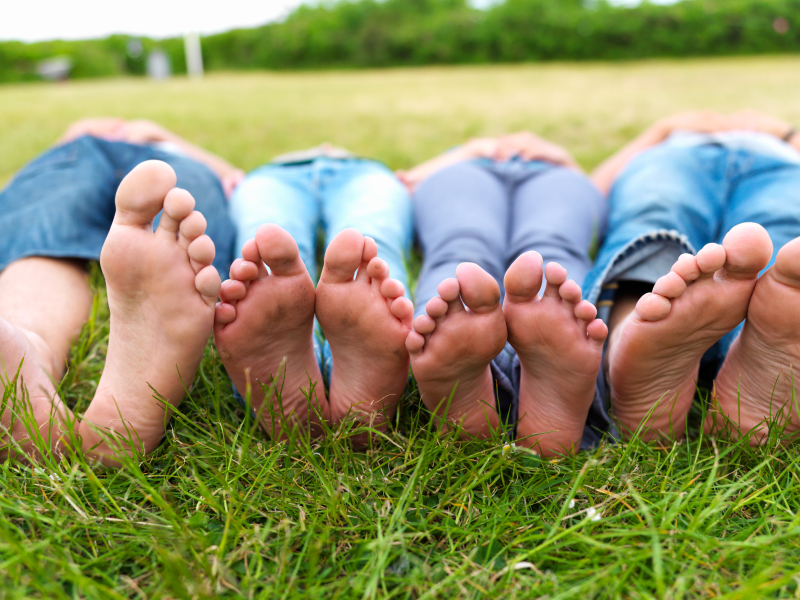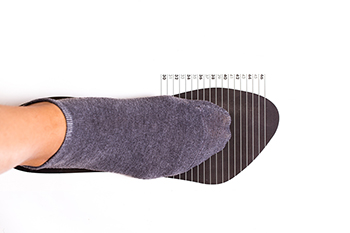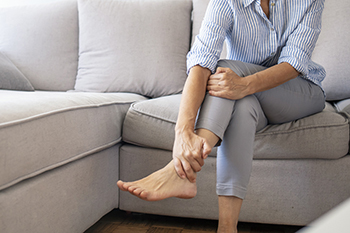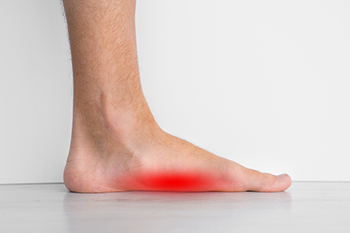Items filtered by date: October 2023
Why the Shape of Your Feet Matters

Your feet are the foundation of your body, and when the shape of your foot is compromised, it can have far-reaching consequences. Wearing Ill-fitting shoes can worsen conditions such as bunions, hammertoes, and plantar fasciitis. They also may lead to biomechanical adjustments that can cause back and joint pain, balance problems, postural issues, and leg discomfort. Foot arches are of three main types, which are high, neutral, and flat. High arches are overly pronounced, causing pressure on the heel and forefoot, while flat feet may restrict mobility and lead to other health problems. In addition, pronation and supination, which refers to the side to side movement of the foot when you stand, walk or run, are factors that need to be considered when buying shoes. Supination involves the foot rolling outward, often affecting those with high arches, and potentially leading to lower leg discomfort like plantar fasciitis. Overpronation occurs when the foot rolls excessively inward, common in people with flat feet, and this can cause discomfort as well as alignment issues throughout the body. For help with issues involving the shape of your feet, it is suggested that you make an appointment with a podiatrist for an evaluation.
If you have any concerns about your feet, contact Anas Khoury, DPM from North Eastern Foot & Ankle Specialists. Our doctor can provide the care you need to keep you pain-free and on your feet.
Biomechanics in Podiatry
Podiatric biomechanics is a particular sector of specialty podiatry with licensed practitioners who are trained to diagnose and treat conditions affecting the foot, ankle and lower leg. Biomechanics deals with the forces that act against the body, causing an interference with the biological structures. It focuses on the movement of the ankle, the foot and the forces that interact with them.
A History of Biomechanics
- Biomechanics dates back to the BC era in Egypt where evidence of professional foot care has been recorded.
- In 1974, biomechanics gained a higher profile from the studies of Merton Root, who claimed that by changing or controlling the forces between the ankle and the foot, corrections or conditions could be implemented to gain strength and coordination in the area.
Modern technological improvements are based on past theories and therapeutic processes that provide a better understanding of podiatric concepts for biomechanics. Computers can provide accurate information about the forces and patterns of the feet and lower legs.
Understanding biomechanics of the feet can help improve and eliminate pain, stopping further stress to the foot.
If you have any questions please feel free to contact our office located in Passaic, NJ . We offer the newest diagnostic and treatment technologies for all your foot and ankle needs.
Are You Suffering From Nerve Damage?
Ensuring a Proper Fit for Shoes and Boots

The key to comfortable footwear lies in getting the right fit. Ill-fitting shoes or boots can lead to a host of issues, including blisters, calluses, and chronic foot problems. To ensure your footwear provides the perfect fit, begin by measuring your feet regularly, as their size can change over time. Always try on both shoes and shop in the afternoon when your feet are slightly larger due to daily activities. Consider the type of socks you will be wearing with your shoes, as this can affect the fit. Pay attention to how the shoes or boots feel, ensuring there is enough space in the toe box, and that your heels do not slip. Walk around in them to test comfort and stability. Lastly, remember that sizes can vary between brands and styles, so rely more on the fit and feel than the size on the label. If you would like additional tips on how to buy shoes that fit properly, it is suggested that you contact a podiatrist who can provide you with the information you are seeking.
Finding a properly-fitting shoe is important in reducing injuries and preventing foot problems. For more information about treatment, contact Anas Khoury, DPM from North Eastern Foot & Ankle Specialists. Our doctor will treat your foot and ankle needs.
Proper Shoe Fitting
A common concern when it comes to foot health, having properly fitted shoes can help prevent injuries to the foot. Out feet affect our posture and gait, which in turn affects the biomechanics and overall bodily structure. With 33 joints, 26 bones, and over 100 ligaments, the potential for serious injury is much greater than one realizes. Although the feet cease growth in adulthood, they still change shape as they mature. Here are some factors to consider when it comes to investing in proper fitting shoes:
- Be sure the shoes fit correctly right away
- Ensure the ball of your foot fits comfortably in the widest portion of the shoes
- Even though they may look fashionable, improper fitting shoes can either create adverse conditions or exacerbate existing ones you may already have
- Walk along a carpeted surface to ensure the shoes comfortably fit during normal activity
Keeping in mind how shoes fit the biomechanics of your body, properly-fitting shoes are vitally important. Fortunately, it is not difficult to acquire footwear that fits correctly. Be sure to wear shoes that support the overall structure of your body. Do your feet a favor and invest in several pairs of well-fitted shoes today.
If you have any questions please feel free to contact our office located in Passaic, NJ . We offer the newest diagnostic and treatment technologies for all your foot and ankle needs.
Different Types of Foot Arthritis

Arthritis is characterized by inflammation in one or more joints, leading to pain and stiffness. It is prevalent in the small joints of the foot and ankle, impacting mobility and daily activities. While there is no cure for arthritis, treatment options can help manage symptoms and slow disease progression. The foot and ankle play vital roles in supporting, balancing, and absorbing shock during activities. These areas contain multiple joints and are susceptible to various forms of arthritis like osteoarthritis, rheumatoid arthritis, and gout. Osteoarthritis gradually erodes joint cartilage, causing pain, stiffness, and bone spurs. Risk factors include age, obesity, genetics, and poor foot alignment. Rheumatoid arthritis is a chronic autoimmune disease that can start in the foot and ankle, leading to joint inflammation, swelling, and deformity. Genetic and environmental factors can trigger this condition. Gout is a painful inflammation that often affects the big toe joint due to the accumulation of uric acid crystals. It can lead to sudden and severe joint pain. If you have foot or ankle discomfort from arthritis, it is suggested that you make an appointment with a podiatrist to determine which kind of arthritis is affecting you.
Arthritis can be a difficult condition to live with. If you are seeking treatment, contact Anas Khoury, DPM from North Eastern Foot & Ankle Specialists. Our doctor can provide the care you need to keep you pain-free and on your feet.
Arthritic Foot Care
Arthritis is a term that is commonly used to describe joint pain. The condition itself can occur to anyone of any age, race, or gender, and there are over 100 types of it. Nevertheless, arthritis is more commonly found in women compared to men, and it is also more prevalent in those who are overweight. The causes of arthritis vary depending on which type of arthritis you have. Osteoarthritis for example, is often caused by injury, while rheumatoid arthritis is caused by a misdirected immune system.
Symptoms
- Swelling
- Pain
- Stiffness
- Decreased Range of Motion
Arthritic symptoms range in severity, and they may come and go. Some symptoms stay the same for several years but could potentially get worse with time. Severe cases of arthritis can prevent its sufferers from performing daily activities and make walking difficult.
Risk Factors
- Occupation – Occupations requiring repetitive knee movements have been linked to osteoarthritis
- Obesity – Excess weight can contribute to osteoarthritis development
- Infection – Microbial agents can infect the joints and trigger arthritis
- Joint Injuries – Damage to joints may lead to osteoarthritis
- Age – Risk increases with age
- Gender –Most types are more common in women
- Genetics – Arthritis can be hereditary
If you suspect your arthritis is affecting your feet, it is crucial that you see a podiatrist immediately. Your doctor will be able to address your specific case and help you decide which treatment method is best for you.
If you have any questions, please feel free to contact our office located in Passaic, NJ . We offer the newest diagnostic and treatment technologies for all your foot care needs.
Understanding the Anatomy of Flat Feet

Flat feet, also known as fallen arches, is a common condition where the arches of the feet appear to be flat or absent. Understanding the anatomy of flat feet can shed light on this condition. The arch of the foot is a vital structural feature, composed of tendons, ligaments, and bones, including the tarsal and metatarsal bones. In individuals with normal arches, these structures work together to absorb shock, distribute weight, and provide stability during movement. However, in individuals with flat feet, these components may not function as effectively. Common causes of flat feet include genetics, injury, or conditions such as tendon dysfunction. When the arch collapses or flattens, it can result in an uneven distribution of weight on the foot, leading to pain, fatigue, and potential musculoskeletal issues. Understanding the anatomy of flat feet is the first step towards seeking appropriate care and management. It is suggested that you consult with a podiatrist who can help individuals with flat feet explore treatment options. These can include wearing orthotics, doing specific exercises, and, in some cases, undergoing surgery to address discomfort and improve foot function.
Flatfoot is a condition many people suffer from. If you have flat feet, contact Anas Khoury, DPM from North Eastern Foot & Ankle Specialists. Our doctor will treat your foot and ankle needs.
What Are Flat Feet?
Flatfoot is a condition in which the arch of the foot is depressed and the sole of the foot is almost completely in contact with the ground. About 20-30% of the population generally has flat feet because their arches never formed during growth.
Conditions & Problems:
Having flat feet makes it difficult to run or walk because of the stress placed on the ankles.
Alignment – The general alignment of your legs can be disrupted, because the ankles move inward which can cause major discomfort.
Knees – If you have complications with your knees, flat feet can be a contributor to arthritis in that area.
Symptoms
- Pain around the heel or arch area
- Trouble standing on the tip toe
- Swelling around the inside of the ankle
- Flat look to one or both feet
- Having your shoes feel uneven when worn
Treatment
If you are experiencing pain and stress on the foot you may weaken the posterior tibial tendon, which runs around the inside of the ankle.
If you have any questions please feel free to contact our office located in Passaic, NJ . We offer the newest diagnostic and treatment technologies for all your foot and ankle needs.
Securing the Home for Effective Fall Prevention

Accidents can happen anywhere, but our homes should be a sanctuary of safety. One common but preventable mishap is falling within the household. These accidents can result in injuries ranging from minor scrapes to foot injuries, making fall prevention a top priority. This can begin with ensuring your home is well lit, especially in high traffic areas and staircases. Removing clutter and hazards from walkways, such as loose rugs or cords, and securing them to the floor or wall are effective fall prevention techniques. Installing handrails on stairs and grab bars in bathrooms is useful for added support. Consider using non-slip mats in the shower and bathtub. Regularly inspect and maintain your flooring to prevent tripping over loose tiles or damaged areas. Wear appropriate footwear with good grip, and be cautious on wet or slippery surfaces. Additionally, it is beneficial to stay active and that can help to maintain strength and balance, reducing the risk of falls. Taking these precautions can transform your home into a safe haven, where the threat of falling is minimized. If you would like more information about how falling can affect the feet in addition to learning about successful prevention methods, it is suggested that you confer with a podiatrist.
Preventing falls among the elderly is very important. If you are older and have fallen or fear that you are prone to falling, consult with Anas Khoury, DPM from North Eastern Foot & Ankle Specialists. Our doctor will assess your condition and provide you with quality advice and care.
Every 11 seconds, an elderly American is being treated in an emergency room for a fall related injury. Falls are the leading cause of head and hip injuries for those 65 and older. Due to decreases in strength, balance, senses, and lack of awareness, elderly persons are very susceptible to falling. Thankfully, there are a number of things older persons can do to prevent falls.
How to Prevent Falls
Some effective methods that older persons can do to prevent falls include:
- Enrolling in strength and balance exercise program to increase balance and strength
- Periodically having your sight and hearing checked
- Discuss any medications you have with a doctor to see if it increases the risk of falling
- Clearing the house of falling hazards and installing devices like grab bars and railings
- Utilizing a walker or cane
- Wearing shoes that provide good support and cushioning
- Talking to family members about falling and increasing awareness
Falling can be a traumatic and embarrassing experience for elderly persons; this can make them less willing to leave the house, and less willing to talk to someone about their fears of falling. Doing such things, however, will increase the likelihood of tripping or losing one’s balance. Knowing the causes of falling and how to prevent them is the best way to mitigate the risk of serious injury.
If you have any questions, please feel free to contact our office located in Passaic, NJ . We offer the newest diagnostic and treatment technologies for all your foot care needs.

